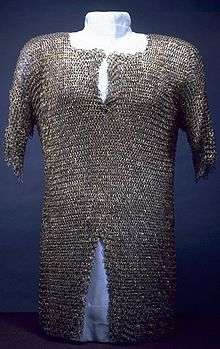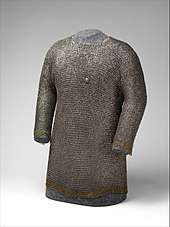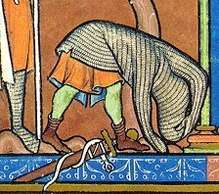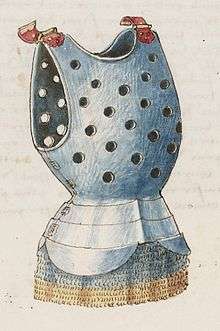Hauberk
A hauberk is a shirt of mail. The term is usually used to describe a shirt reaching at least to mid-thigh and including sleeves. Haubergeon ("little hauberk") generally refers to a smaller version of the hauberk, but the terms are often used interchangeably.

History
The word hauberk is derived from the Old Frankish word halsberg (c. 1300),[1] which originally described a small piece of mail that protects ("bergen", literally "to give protection, to save, to rescue") the throat and the neck (the "Hals").
The short-hemmed, short-sleeved hauberk originated from the medieval Islamic world[2] The Bayeux Tapestry illustrates Norman soldiers wearing a knee-length version of the hauberk, with three-quarter length sleeves and a split from hem to crotch. Such armor was quite expensive—both in materials (iron wire) and time/skill required to manufacture it—so common foot soldiers rarely were so equipped.

The hauberk stored in the Prague Cathedral, dating from the 12th century, is one of the earliest surviving examples from Central Europe and was supposedly owned by Saint Wenceslaus. In Europe, use of mail hauberks continued up through the 14th century, when plate armor began to supplant it. In parts of Central Asia, it continued to be used longer.
In Japan, a form of hauberk called kusari katabira (chain jacket) was commonly worn by the samurai class and their retainers.
In the Hebrew Bible the shiryon, translated "habergeon" or a "coat of mail," is mentioned as part of the armor of Nehemiah's workers (Nehemiah 4:16), and one of the pieces of armor supplied by King Uzziah to his soldiers. (2 Chronicles 26:14) Goliath was also armed with a "coat of mail", weighing five thousand shekels (55 kg[3]), as he confronted David (1 Samuel 17:5).[4]
Construction

The hauberk is typically a type of mail armour which is constructed of interlocking loops of metal woven into a tunic or shirt. The sleeves sometimes only went to the elbow, but often were full arm length, with some covering the hands with a supple glove leather face on the palm of the hand, or even full mail gloves. It was usually thigh or knee length, with a split in the front and back to the groin so the wearer could ride a horse. It sometimes incorporated a hood, or coif.
Gallery
- Polish hauberk.
 Sudanese hauberk.
Sudanese hauberk. European hauberk
European hauberk- Japanese hauberk.
- Indian mail and plate hauberk.
See also
- Mail (armour)
- Mail and plate armour
- Mail Coif
References
- http://www.etymonline.com/index.php?allowed_in_frame=0&search=hauberk&searchmode=none
- David Nicolle (1994), Saracen faris 1050-1250 A.D., Osprey Publishing, p. 58, ISBN 1-85532-453-9
- Tenney, Merril ed., The Zondervan Pictorial Encyclopedia of the Bible, vol. 5, "Weights and Measures," Grand Rapids, MI: Zondervan, 1976.
- "www.Bibler.org - Dictionary - Habergeon". Retrieved 2012-11-27.
